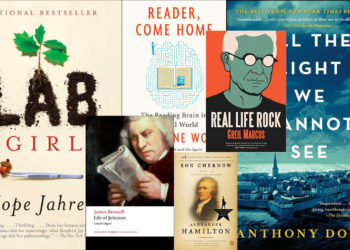Editor’s Note: Continuing an annual tradition, we take a moment to pause at year’s end to look back on the best books we encountered. As always, this is not a “best books of 2018″ list, but a list of the best books the Chefs read during 2018 — the books might be classics, a few years old, or brand new. This is one of the great things about books in all forms — they endure, invite visitation and revisitation, and beckon with ideas. Here’s Part 2 of our list, Part 1 is available here.
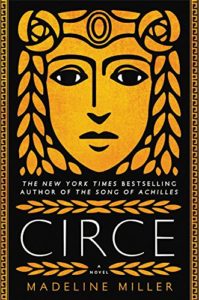 Jill O’Neill: My best fiction read this year was Circe by Madeline Miller. The novel refashions stories told by Ovid and Homer of Circe, the goddess of transformation and the first witch in Western literature. The author provides Circe with a powerful voice in expressing a series of life experiences specific to women, beyond the Classical sense of maiden, matron and crone.
Jill O’Neill: My best fiction read this year was Circe by Madeline Miller. The novel refashions stories told by Ovid and Homer of Circe, the goddess of transformation and the first witch in Western literature. The author provides Circe with a powerful voice in expressing a series of life experiences specific to women, beyond the Classical sense of maiden, matron and crone.
We hear Circe speak of a witch woman’s experience in learning the nature of her gift of sorcery and recognizing how to exert and manage that power. It is not an intuitive process, but one demanding of time and energy. Banished to an isolated setting, Circe ultimately comes to understand her unique powers through experimentation and failure. Those beings fortunate enough to live on Mount Olympus have no notion of the process and it proves to be (if you’ll excuse a poor joke) their Achilles’ heel. The reader encounters other memorable women who also learn and exercise the scope of their power — Penelope the Weaver awaiting Odysseus’ return from the Trojan War, Pasiphae giving birth to the Minotaur. This is the sort of re-telling that leads one back to the original source material.
Miller’s prose style is reminiscent of that of Ursula K. LeGuin — sparse and specific in its use of vocabulary and clear sentence structures. And just like the works of LeGuin, the novel is deceptively easy to read, all the while quietly inviting the reader to re-think issues of power, pride, deception, and ultimately, acceptance.
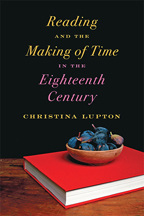 Having noted the best bit of fiction I read in 2018, may I also recommend two works of non-fiction? I thoroughly enjoyed Christina Lupton’s Reading and the Making of Time in the Eighteenth Century and the brief glimpses into the lives of Catherine Talbot and Elizabeth Carter, two intellectuals (or bluestockings, if you will) struggling to find time to read in a period that we would think of as moving more slowly than our own. And in thinking about users engaging with content, I would recommend the excellent work by the Multigraph Collective, Interacting with Print: Elements of Reading in the Era of Print Saturation. Rather than being a collection of
Having noted the best bit of fiction I read in 2018, may I also recommend two works of non-fiction? I thoroughly enjoyed Christina Lupton’s Reading and the Making of Time in the Eighteenth Century and the brief glimpses into the lives of Catherine Talbot and Elizabeth Carter, two intellectuals (or bluestockings, if you will) struggling to find time to read in a period that we would think of as moving more slowly than our own. And in thinking about users engaging with content, I would recommend the excellent work by the Multigraph Collective, Interacting with Print: Elements of Reading in the Era of Print Saturation. Rather than being a collection of 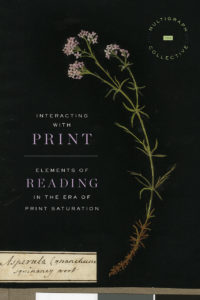 chapters by individual authors, subsequently refined by two or three editors, this book represents a modern act of synthesis by scholars working with digital tools, processing meaning and producing in the end an additional depth of understanding. My take-away (as a non-expert) is that the structure and production of the final printed output lent value for the reader of the eighteenth and nineteenth century. As an example, one might not think much about the frontispiece which has largely disappeared from mainstream print publications but its role in establishing the entrance to a work and the authority of the author is most intriguing. Other chapters touch on everything from the mundane practicalities of book production (binding, paper, etc.) to less tangible aspects (ephemerality). Both books offer the chance to consider the priority of reading amidst the press of other activities as well as the perceptions formed of and during the reading experience.
chapters by individual authors, subsequently refined by two or three editors, this book represents a modern act of synthesis by scholars working with digital tools, processing meaning and producing in the end an additional depth of understanding. My take-away (as a non-expert) is that the structure and production of the final printed output lent value for the reader of the eighteenth and nineteenth century. As an example, one might not think much about the frontispiece which has largely disappeared from mainstream print publications but its role in establishing the entrance to a work and the authority of the author is most intriguing. Other chapters touch on everything from the mundane practicalities of book production (binding, paper, etc.) to less tangible aspects (ephemerality). Both books offer the chance to consider the priority of reading amidst the press of other activities as well as the perceptions formed of and during the reading experience.
David Crotty: 2018, much like 2017, has been a year of necessary distraction. As many of us feel compelled to obsessively follow the news (both political and environmental), so must we also be able to recognize those moments when it becomes overwhelming, and allow ourselves the respite and re-energizing that can come from immersing oneself in a great work of art. A few things that have helped me get through the year:
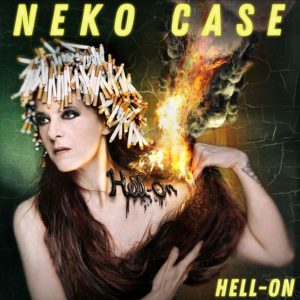 Hell-On by Neko Case: My favorite record this year (Courtney Barnett’s Tell Me How You Really Feel a close second), Case’s latest album is both gorgeous and heartbreaking, the perfect combination of outrage and compassion for 2018.
Hell-On by Neko Case: My favorite record this year (Courtney Barnett’s Tell Me How You Really Feel a close second), Case’s latest album is both gorgeous and heartbreaking, the perfect combination of outrage and compassion for 2018.
Bad Blood: Secrets and Lies in a Silicon Valley Startup: This year was a tough one for non-fiction reading for me, as escapism largely ruled the roost (try Naomi Novik’s Spinning Silver for her mash-up of Rumpelstiltskin and the Persephone myth as a Jewish folk tale). I don’t read a lot of business books as a practice, but this was given to me as a gift and I quickly found myself swept up in what, in retrospect, seems like far too unbelievable a grift to have really happened. 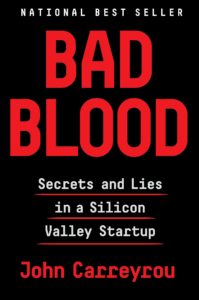 Written by Wall Street Journal reporter John Carreyrou, the book tells the story of Theranos, once the highest valued startup in the world, which promised a revolutionary technological approach to blood testing. Their product, as we now know, was pure vapor, and never really existed, but this didn’t stop the company from going so far as to set up shop in Walgreens stores to collect blood (and fake results) from patients. The book reads like an Ocean’s 11 heist story, as the sheer audacity of Theranos and its founder Elizabeth Holmes beggars belief. It’s a great display of the hubris that seems a steady part of the culture in Silicon Valley, as well as a reminder of how poorly their standard approaches translate to medicine and the human body, which is not just another algorithm to be hacked.
Written by Wall Street Journal reporter John Carreyrou, the book tells the story of Theranos, once the highest valued startup in the world, which promised a revolutionary technological approach to blood testing. Their product, as we now know, was pure vapor, and never really existed, but this didn’t stop the company from going so far as to set up shop in Walgreens stores to collect blood (and fake results) from patients. The book reads like an Ocean’s 11 heist story, as the sheer audacity of Theranos and its founder Elizabeth Holmes beggars belief. It’s a great display of the hubris that seems a steady part of the culture in Silicon Valley, as well as a reminder of how poorly their standard approaches translate to medicine and the human body, which is not just another algorithm to be hacked.
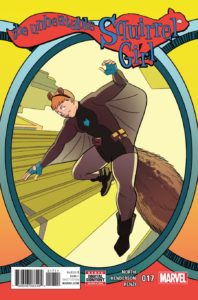 The Unbeatable Squirrel Girl: Being both a comics nerd and a parent can be problematic. You want to share your joy with your offspring, but so many of the best comics are not appropriate for younger readers. Going back to look at what I enjoyed at a young age, I cringe at the overly-violent male fantasies filled with scantily clad female heroes with unrealistic body types — not the kind of stuff I’m comfortable raising my kid on. Fear not, true believer, for the Unbeatable Squirrel Girl is here for all your parental recommendation needs. First year computer science student Doreen Green, blessed with both the powers of squirrels and girls, is the most powerful character in the Marvel universe, having singlehandedly defeated Dr. Doom, Ultron, Thanos, and Galactus. Aside from super strength and leaping abilities, her real secret power is empathy — a willingess to listen to villains, to care about their problems, and to figure out a reasonable compromise that lets everybody win. She also frequently uses the mathematics and the concepts behind computer programming to win the day. Punching bad guys really hard does occasionally happen, but usually as a last resort. The comic is filled with multi-cultural characters, with largely realistic body types. It’s smart, hilarious, and a really fun read for all ages. Highlights include her remake of the Spider-Man theme song, Twitter conversations with Tony Stark and The Hulk, and the time she had to beat up all of the Avengers because they were being totally sassy and rude. Highly recommended.
The Unbeatable Squirrel Girl: Being both a comics nerd and a parent can be problematic. You want to share your joy with your offspring, but so many of the best comics are not appropriate for younger readers. Going back to look at what I enjoyed at a young age, I cringe at the overly-violent male fantasies filled with scantily clad female heroes with unrealistic body types — not the kind of stuff I’m comfortable raising my kid on. Fear not, true believer, for the Unbeatable Squirrel Girl is here for all your parental recommendation needs. First year computer science student Doreen Green, blessed with both the powers of squirrels and girls, is the most powerful character in the Marvel universe, having singlehandedly defeated Dr. Doom, Ultron, Thanos, and Galactus. Aside from super strength and leaping abilities, her real secret power is empathy — a willingess to listen to villains, to care about their problems, and to figure out a reasonable compromise that lets everybody win. She also frequently uses the mathematics and the concepts behind computer programming to win the day. Punching bad guys really hard does occasionally happen, but usually as a last resort. The comic is filled with multi-cultural characters, with largely realistic body types. It’s smart, hilarious, and a really fun read for all ages. Highlights include her remake of the Spider-Man theme song, Twitter conversations with Tony Stark and The Hulk, and the time she had to beat up all of the Avengers because they were being totally sassy and rude. Highly recommended.
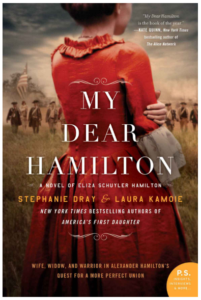 Angela Cochran: Hamilton fever hit my house hard this year. The instigator was my 11-year-old daughter who is the world’s largest history fan. We haven’t seen the show, but the entire house knows the soundtrack by heart.
Angela Cochran: Hamilton fever hit my house hard this year. The instigator was my 11-year-old daughter who is the world’s largest history fan. We haven’t seen the show, but the entire house knows the soundtrack by heart.
The first time I listened to the soundtrack from start to finish was on a flight. I don’t recommend this as it may invoke uncontrollable sobbing. (If you want to see why Hamilton music makes you cry, there is a great video series by composer Howard Ho to explain it.)
Immediately upon my first run through, I wanted to know more about Eliza Schuyler Hamilton, Alexander’s wife. She’s a founding mother that few people know about. In fact, I had a hard time finding a biography of her that was not just one short chapter in a book about other “revolutionary wives”. In my search, I found My Dear Hamilton: A Novel of Eliza Schuyler Hamilton by Stephanie Dray and Laura Kamoie. Before you get all excited, remember it’s a work of fiction, just as is our non-stop musical.
There aren’t a lot of writings from Eliza that tell her story. Lin-Manuel Miranda, playwright of Hamilton, dramatized this lack of information by portraying Eliza as having “removed herself from the narrative” after her husband’s infidelities. But more about the book….
This particular story of Eliza is about a woman who is the “sensible” daughter of the well-to-do Schuyler family in Albany, New York. She is smart, charitable, and understated. This makes her a reliable story teller as she is not swept away by drama and unrealistic fantasies. The daughter of a decorated General who was stripped of his command for losing Fort Ticonderoga to the British, she was very much a diplomat. Eliza’s personality made her an easy friend of people like Martha Washington, James and Dolly Madison, James Monroe, and the Marquis de Lafayette. The fact that she lived well into her 90s gives her an interesting perspective on the founding of the nation.
Eliza is also a tortured character. Betrayed not just by her husband, but also those she considered honorable allies such as Thomas Jefferson, James Madison, and perhaps most famously, her older sister. The book takes the reader through every painful moment and is truly a story about forgiveness and strength. Having lost her oldest child, she also dealt with the mental illness of her second child, all the while putting up with her erratic husband and five other children (there was a sixth that died as an infant).
What I truly loved about this book is that it’s not a book about Alexander Hamilton as seen through the eyes of his wife. It’s about her. It’s about her family. It’s about the amazing things she did for widows (even when she herself became a widow with very little money). She was the cofounder of an orphanage and later ran a school for the children of freed slaves. She documented her husband’s contribution to the nation when so many people were against her doing that.
This past summer, my family went to upstate New York to visit my brother’s family. We took a side trip to Schuylerville, the town with the summer home of the Schuylers as well as their lumber mill, fishery, and other industry that made them their fortune. General Burgoyne burned it all down during the Battle of Saratoga. We visited the rebuilt Schuyler house and never once on the tour do they mention Alexander Hamilton. This felt right given that his oversized personality likely reigned over much of their history.
Reading this novel, with the dramatic license that’s missing from the short biographies, reminded me of reading Overlooked, the New York Times obituary collection. Overlooked was launched earlier this year and presents the life stories of women and people of color that were incredibly important and yet deemed not worthy of a Times Obit at their time of death. Women such as Ida B. Wells, Sylvia Plath, and Emily Warren Roebling did not qualify for obits — an error now being corrected.
The final song of the musical Hamilton asks, “who lives, who dies, who tells your story?” For Alexander Hamilton, it was Eliza. She spent most of her time as a widow trying to get a biography of her husband written. I suppose this is why we don’t have a whole lot of information about her. She never wrote her own story.
As a work of historical fiction, I greatly enjoyed this novel. For any young Hamilton fans in your family, I can also recommend Hamilton and Peggy!: A Revolutionary Friendship by L.M. Elliott. It tells the same story, but from a younger Schuyler sister’s perspective and for a Young Adult audience.
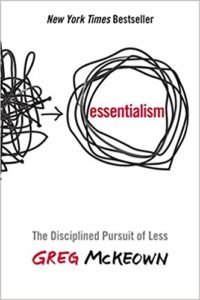 Judy Luther: Greg McKeown’s Essentialism: The Disciplined Pursuit of Less made the New York Times Best Sellers List when published in 2014. Essentialism is about doing less and accomplishing more. It requires that we are clear about the choices we make everyday and the tradeoffs that go with them. The belief that ‘I can have it all’ leads us to spread ourselves too thin which is damaging to our health, well-being and happiness. He advocates that we recognize the power of choice and the view that “I can do anything, but not everything”.
Judy Luther: Greg McKeown’s Essentialism: The Disciplined Pursuit of Less made the New York Times Best Sellers List when published in 2014. Essentialism is about doing less and accomplishing more. It requires that we are clear about the choices we make everyday and the tradeoffs that go with them. The belief that ‘I can have it all’ leads us to spread ourselves too thin which is damaging to our health, well-being and happiness. He advocates that we recognize the power of choice and the view that “I can do anything, but not everything”.
There are two other best sellers that I feel are related in that they highlight considering what is important and the role of choice.
- Stephen Covey, in The 7 Habits of Highly Effective People first published in 1989, emphasized “putting first things first” by distinguishing between what is urgent and what is important, and choosing the latter.
- Marie Kondo’s The Life-Changing Magic of Tidying Up: the Japanese Art of Decluttering and Organizing, released in 2014, advises us to evaluate what we own and to choose to keep only those things that bring us joy, thereby creating more a restful space.
The common thread across all three books deals with reducing or eliminating that which consumes our time or space without contributing to what is important in our lives. Making intentional choices that improve the quality of our lives requires discernment about what is of value to us.
Greg’s book is an easy read and effectively combines both the rationale and approaches for how to change our reflex responses to considered replies that will serve long term interests rather than short term needs. Regardless of whether we’re choosing what’s important (Covey), keeping what brings us joy (Kondo), or selecting fewer activities (McKeown) — the objective is to have a better / more satisfying life by understanding the value of the choices we make.
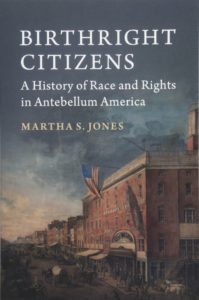 Karin Wulf: Reading is a political act.
Karin Wulf: Reading is a political act.
I read some really wonderful books this year, and added a huge number to my “must read” pile. Among the very best, and one I’m urging family and friends as well as colleagues to read, is Birthright Citizens: A History of Race and Rights in Antebellum America by Martha Jones. Birthright Citizens takes up an issue with clear contemporary resonance. How does anyone, born in the United States or born abroad, become a citizen, and what rights are conferred by, let alone guaranteed by citizenship? These questions have always been complex and contested. A recent post on Lawfare about whether birthright citizenship can be imperiled by executive order is worth a read, lest anyone think that the answer is obvious or easy. Jones, on the history faculty at Johns Hopkins University, holds a J.D. (and was a public interest lawyer) as well as a Ph.D. and has written widely about the subject of citizenship in a year that by any standard brought a lot of public attention to the issue of how and for whom American citizenship is defined. You can read her essay for the The Atlantic here, and an interview with Jennifer Schuessler of the New York Times here.
The reason to read the full book as well as the op-eds and reviews, though, is to appreciate the complexity of the way law is experienced and shaped by ordinary people. The study is set in Baltimore, “a place between North, South and the Atlantic World,” a key antebellum site because of the city’s size (3rd largest in the U.S.) and the number of free black Baltimoreans (largest community in the U.S.). Chapter by chapter we meet individuals and families who gained knowledge of the law and then leveraged it to help themselves and their community. Race and rights were issues not confined to straightforward distinctions between slavery and freedom, but to the marrow between, where what “freedom” meant was a matter of deeply contested law and practice. There are black activists and professionals, editors and writers and publishers, and Frederick Douglass. But mostly there are men and women like sailor George Hackett, whose travels bring home the way that moving across national boundaries highlight questions of citizenship and differential interpretations of race and rights.
Birthright Citizens is a great example of a newer approach to legal history, which rather than focusing on written law or judicial findings, centers on how ordinary people understood, interacted with, and ultimately shaped the law. It is published in Studies in Legal History, the book series of the American Society for Legal History and I defy anyone not to find books on this list that you’d want to read right away. Robert Gordon’s Taming the Past: Essays on Law in History and History in Law, looking at how lawyers and judges have always invoked a flattened, cleaner version of the past for current purposes, is another one for useful current consideration. I taught another recent book on this list, Michelle McKinley’s Fractional Freedoms: Slavery, Intimacy, and Legal Mobilization in Colonial Lima, 1600-1700 and the analysis of how, somewhat akin to Jones’s Baltimoreans, enslaved women came to know and to leverage the law in aid of their children, families, and themselves is another stunningly creative and important work.
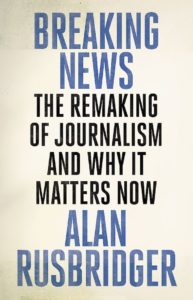 David Smith: “In an age of information chaos and crisis, journalists feel they have to win the argument that there is a category of information — let’s call it ‘proper’ news — which is better than and distinct from, all the other stuff out there. Winning that argument seems crucial to the future of journalism.” Alan Rusbridger Editor-In Chief (EiC) of The Guardian 1995 – 2015.
David Smith: “In an age of information chaos and crisis, journalists feel they have to win the argument that there is a category of information — let’s call it ‘proper’ news — which is better than and distinct from, all the other stuff out there. Winning that argument seems crucial to the future of journalism.” Alan Rusbridger Editor-In Chief (EiC) of The Guardian 1995 – 2015.
My book of the year is Rusbridger’s Breaking News: The Remaking of Journalism and Why It Matters Now, a book that is both a history of his time as a journalist and EiC of The Guardian, and a far wider analysis of the state of play for those organizations that are in the business of information. He details some of the background of the big stories that The Guardian broke (and some of the those accounts are eye-popping), but he also details the struggle to figure out how to do information in a ever changing digital world. His tenure as EiC matches that of many of us who got in to the scholarly publishing business, so us ‘older lags’ will be reminded of much that we’ve dealt with (or perhaps not) in the last 20 years. For you younglings out there, this will tell a tale of what it was like when the search engine with the funny name suddenly showed up. About a time when the “Attention Economy” and “The Long Tail” were The New New Things that had to be assessed and grappled with; the growing realization of what one can do with ridiculous amounts of venture capital to play with and support from investors actively gambling on which businesses could scale the left side of the Pareto distribution.
Rusbridger’s lens is ‘journalism’. But in reading it, there are whole tracts where one can simply replace the J word with ‘Scholarly Publishing’ and realize that the same issues and tensions were/are at play. Personally speaking, as someone who knew some of the developers that worked at The Guardian around the turn of century, it’s also fascinating to see the EiC openly talk about his struggle to figure out what the tech wizards were up to. And then to see how he came to realize the cultural changes that needed to happen in order for the organization to remain relevant.
And what shines though, is the passion. The belief in public good. The simple fact that good information is worth fighting for.
Author disclosure: I’m a Guardian Member. I pay to support the work that they do, because for every Monbiot, there’s a Carole Cadwalladr ferociously speaking truth to power. If you don’t support proper journalistic endeavor, give some thought to doing so if you have the funds.
Discussion
9 Thoughts on "Chefs’ Selections: The Best Books Read During 2018 Part 2"
David Crotty, thanks for the recommendation of the Unbeatable Squirrel Girl. My son is not a huge fiction reader and his teacher recommended comics to pull him in. We faced the same issue of 2018 age-appropriate comics and Squirrel Girl sounds like a perfect combination of all we were seeking.
David Smith, I agree with your end note that we should support quality journalism. I purchased subscriptions last year to two newspapers on top of our annual donations to NPR. ProPublica is another source of excellent investigative journalism that deserves to be supported. Thanks for the reminder.
Comics are a gateway drug to books. If your kid is into the Marvel movies, Squirrel Girl has many of the same characters, which works as a good hook. Best to start at the beginning, first collection is Volume 1, Squirrel Power. We also enjoyed Jeff Smith’s “Bone” series, and “The Three Thieves” by Scott Chantler if you want some non-superhero stuff.
I LOVE Squirrel Girl and love reading it with my kids. We also all enjoy Bone, My Little Pony and – of course – Calvin and Hobbes, (which is bizarrely called Tommy and the Tiger here in Norway). Although I think a lot of the existential philosophy goes a bit over their heads…
Loved Madeleine Miller Circe – Song of Achilles is also well worth reading.
David Crotty, you should have a look towards European, and specifically French and Belgium, Graphic novels. Lots there of excellent quality, for all ages! 🙂
David Smith, I had exactly the same thought when reading Rusbridger. The grappling with technology seemed very familiar somehow. A great read as well.
Commenter disclosure: More or less the same as you.
p.s. my favourite book was: Just kids by Patti Smith. Not new, but a beautifully written autobiographical work
Well, this was a surprise. I expected STM/HSS chefs to recommend STM/HSS books. We have enough websites recommending fiction/trade (non-scholarly) lists at this time of the year. Don’t you read any books, say of Business & Management, that you can recommend?
Surprise? We’ve been doing this annually since 2011 (https://scholarlykitchen.sspnet.org/2011/12/21/chefs-selections-the-best-books-read-during-2011/). Looking back, very few business/management books ever make our list. Some of this is because most are pretty bad (most seem like a long blog article stretched out to book length). But largely, we are an eclectic group with eclectic interests, and there’s more to life than business…
Desieditor wrote: “I expected STM/HSS chefs to recommend STM/HSS books.” If Boswell’s “Life of Johnson” is not core to HSS studies, I don’t know what is.

